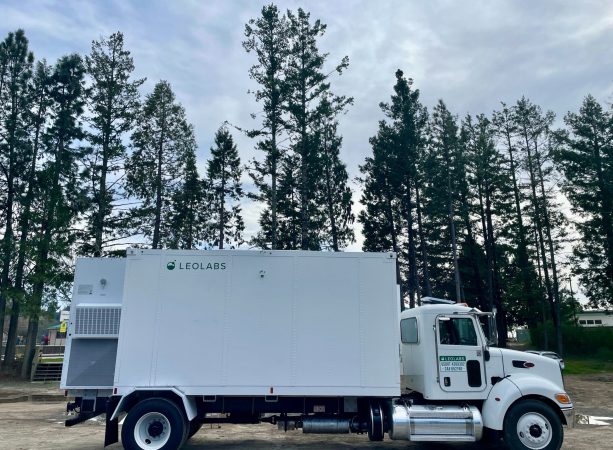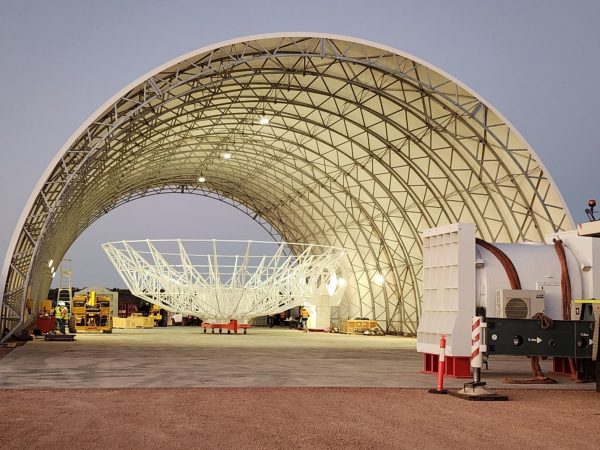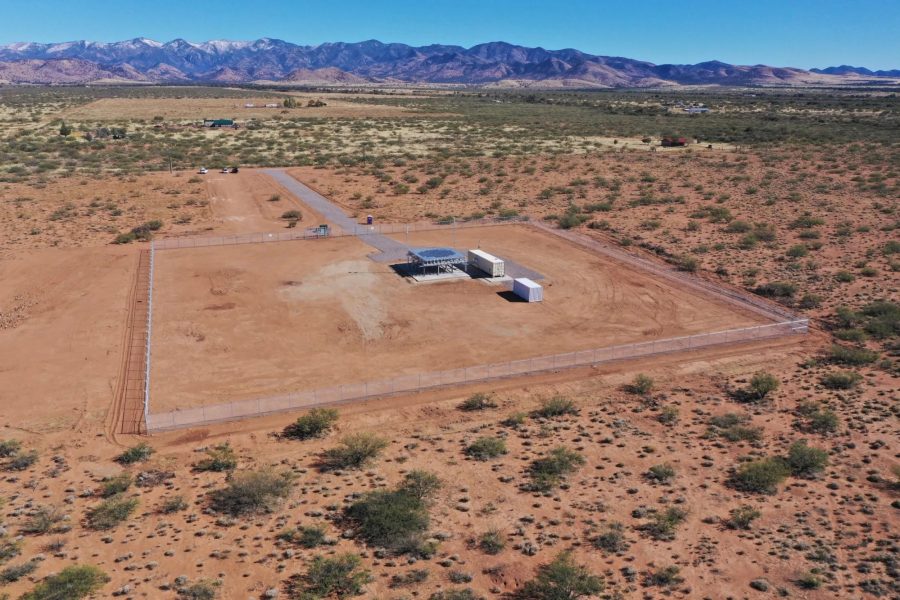COLORADO SPRINGS, Colo.—As the Space Force looks to expand its ability to track objects in orbit, a series of ground-based radars coming in the next few years could help fill gaps in coverage.
Better space domain awareness—essentially intelligence, surveillance, and reconnaissance on satellites—is one of the top priorities of USSF leadership, who want to be able to track more threats and have a deeper understanding of what they’re doing, especially as competitors like China maneuver their satellites more and more. To do so, the service can use its own spacecraft or sensors on the ground.
Col. Bryon McClain, program executive officer for space domain awareness (SDA) and combat power, told reporters at the Space Symposium that he is taking a “both/and” approach.
“The answer is always ‘I want more,’ and space-based fills in gaps that ground-based systems can’t always grab. Ground-based systems fill in gaps that space-based systems can’t grab. To me, it’s a mix,” he said.
Yet ground-based radars in particular seem to be how the Space Force is trying to boost coverage in the near term, especially over the Indo-Pacific region, while it plans other long-term upgrades.
Low-Earth Orbit
To keep an eye on the increasingly congested low-Earth orbit, the Space Force innovation arm SpaceWERX announced a $60 million Strategic Funding Increase for startup LeoLabs last month to build a new radar at a to-be-determined site in the Indo-Pacific.
At the Space Symposium, LeoLabs CEO Tony Frazier told Air & Space Forces Magazine that the radar will be an ultra-high frequency system from the company’s line of “next-generation radar technology.”
“It’s a direct radiating array, meaning that it emits a cone of energy that allows us to be able to detect new things in space,” Frazier said. “So new foreign launches, keeping track of highly maneuverable spacecraft … the intent is to be able to detect new foreign launches within minutes, and then be able to provide early warning, you know, to a variety of customers.”
LeoLabs has already built one such radar in Arizona thanks in part to a previous Small Business Innovation Research contract from AFWERX, the Air Force innovation arm. The firm built that radar in just five months and has been able to track thousands of satellites, Frazier said, providing a larger field of regard than previous radars.
The goal is to select a site for the new radar soon, in consultation with the Space Force, and start building fast so the system can be up and running by January 2027.
The $60 million for the effort is coming from multiple sources, including the Air Force Research Laboratory, private funding, and U.S. Space Command, which wants to “field better SDA capability more quickly,” USSPACECOM Commander Gen. Stephen N. Whiting said in a keynote address.
The new LeoLabs radar, called Seeker, “will improve DOD’s ability to minimize gaps in SDA coverage and provide early detection and tracking for space and missile launches in China,” he added.
LeoLabs also unveiled another new radar at the Space Symposium, a mobile S-band radar it calls Scout. The system can be transported by truck or cargo ship and even used at sea, Frazier said—making it ideal for tracking China in the Indo-Pacific.

“Our intent is with dozens of these systems deployed, we would be able to provide full coverage, where today, because of some of the limitations of networks like the Space Surveillance Network, those systems are really powerful radars … but most of them are clustered in the Northern Hemisphere,” Frazier said. “There’s big gaps in in the Southern Hemisphere and equatorial regions, over open oceans, where having this distributed network you would be able to fill those gaps and give the adversary less opportunities to maneuver.”
While the Space Force and Space Command have not procured any Scout radars yet, Frazier said the company is seeing strong interest and working with the Pentagon.
“We’re going to build the first four to five systems this year, we’re already planning to do testing in INDOPACOM, so we have a commitment around that,” he said.
LeoLabs is one of several startups focused on space domain awareness getting attention from the Pentagon. Within the past few weeks, AFWERX funded the development of an AI-powered tool for identifying and tracking objects in low-Earth orbit, even as they maneuver and try to cloak themselves, from Slingshot Aerospace. The Defense Innovation Unit has also contracted with startup ExoAnalytic Solutions.
Geosynchronous Orbit
While LeoLabs is focused on tracking objects closer to Earth, the Space Force is also working on systems for SDA all the way out to geosynchronous orbit, some 22,000 miles up.
McClain told reporters that GBOSS (Ground-Based Operational Surveillance System), a planned upgrade for the existing Ground-Based Electro-Optical Deep Space Surveillance radars, is currently being tested at a GEODSS facility in White Sands Missile Range in New Mexico. Budget documents indicate the service hopes to operationally accept the system this year, followed by testing and acceptance at the GEODSS facility in Maui, Hawaii, in 2026.
Meanwhile, the Space Force continues to work on its new Deep-Space Advanced Radar Capability. Construction on the first of three sites concluded in Australia in February, and a second site has already been picked in the United Kingdom. A third site is planned in the U.S.—McClain mentioned Texas as a possibility—but no final decisions have been made, a Space Systems Command spokesperson said.
“That’s going to get amazing capability … out to GEO,” McClain said.
The Australia site is still slated to go live in 2027.
At the same time, McClain’s team is also following a directive from acting acquisition czar Maj. Gen. Stephen Purdy to review the program’s requirements and determine if they could be met using only commercial products.

“We are looking at all options to make sure that we don’t stay locked into something, even if it’s extremely expensive, because we signed a trilateral [memorandum of agreement],” McClain said. “DARC brings such a phenomenal capability. There is not a simple, out-of-the-box, commercial solution. But this is where I fall back on an ecosystem. Do we have the right mix of DARC systems in the right locations? Maybe there are areas where I can augment a little more commercial and adjust the cost curve. So perhaps we still end up with three DARCs. Perhaps we end up with two DARCs … but new commercial aspects in Australia, U.K., or in the United States that help broaden that scope. I don’t have a solid answer because the team is analyzing what Gen. Purdy asked us to analyze.”
Space-Based
With the new and updated radars set to come online in the next few years, the Space Force’s planned spending on ground-based space domain awareness is projected to be a healthy $1.7 billion from 2025 to 2029, according to budget documents.
Space-based SDA, by comparison, is a much smaller $784 million. Budget documents indicate much of that is going to support and expand the Silent Barker program the Space Force worked with the NRO to launch, as well as upgrades, research, and development.
Yet McClain said that new systems may be coming. In March 2024, his office released a request for information from industry on a new generation of satellites that can do space domain awareness, like the Space Force’s current Geosynchronous Space Situational Awareness Program.
Since then, market research has been ongoing, McClain said. And while there may not yet be a program in budget documents, “I don’t think it’s very far off,” he suggested.
